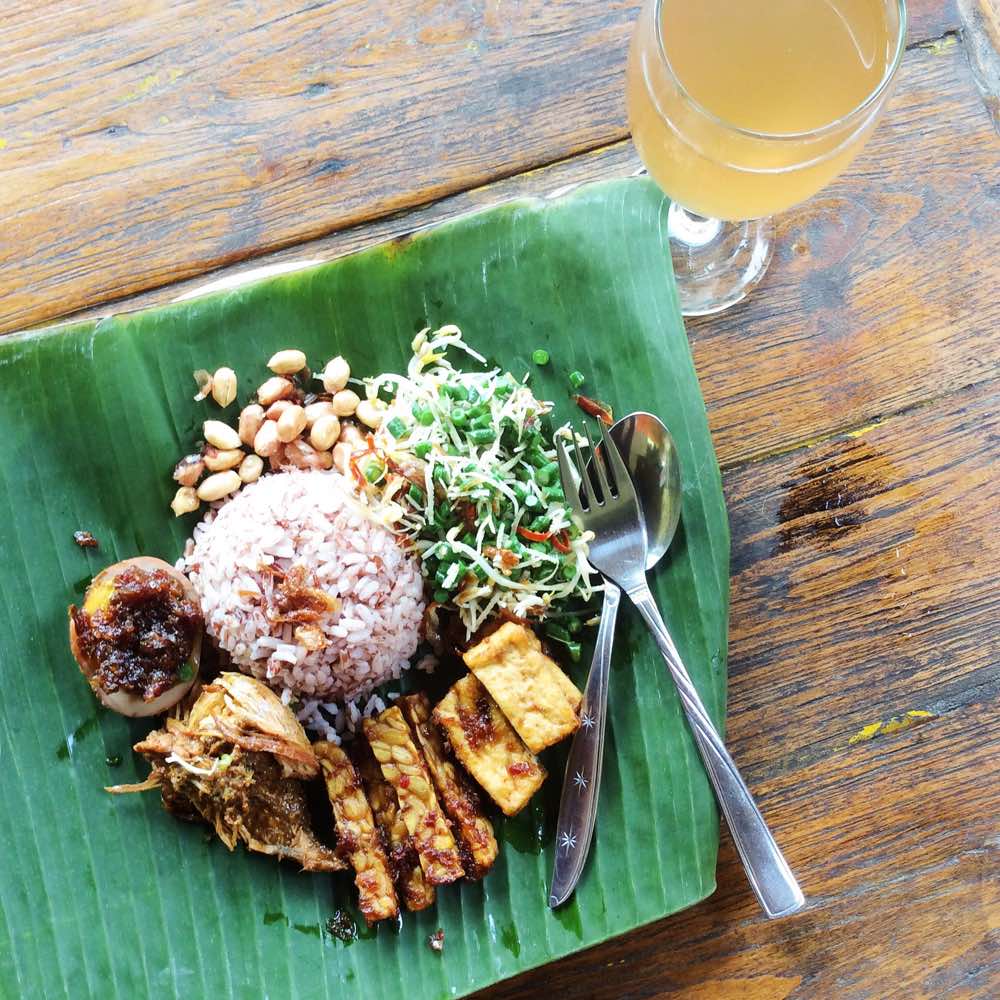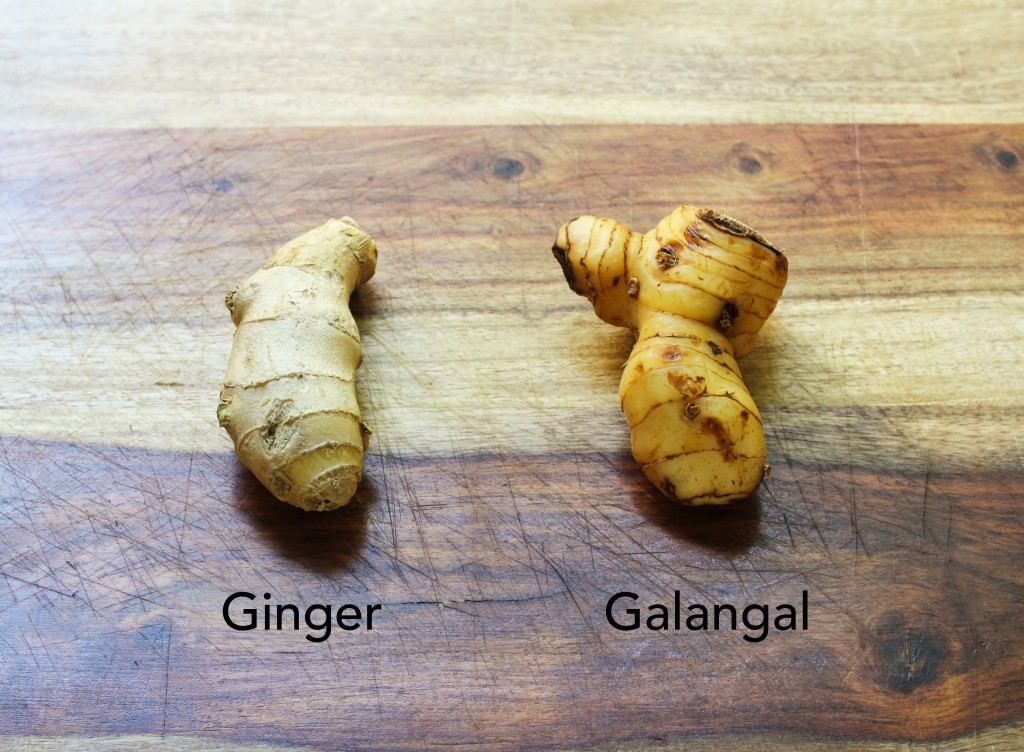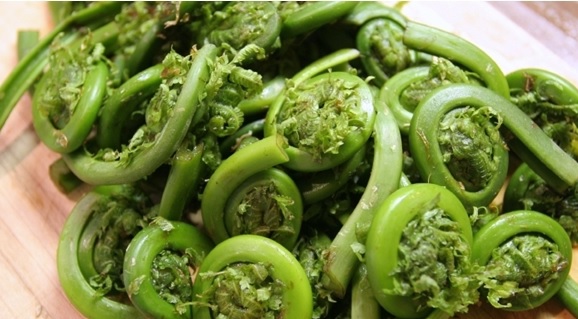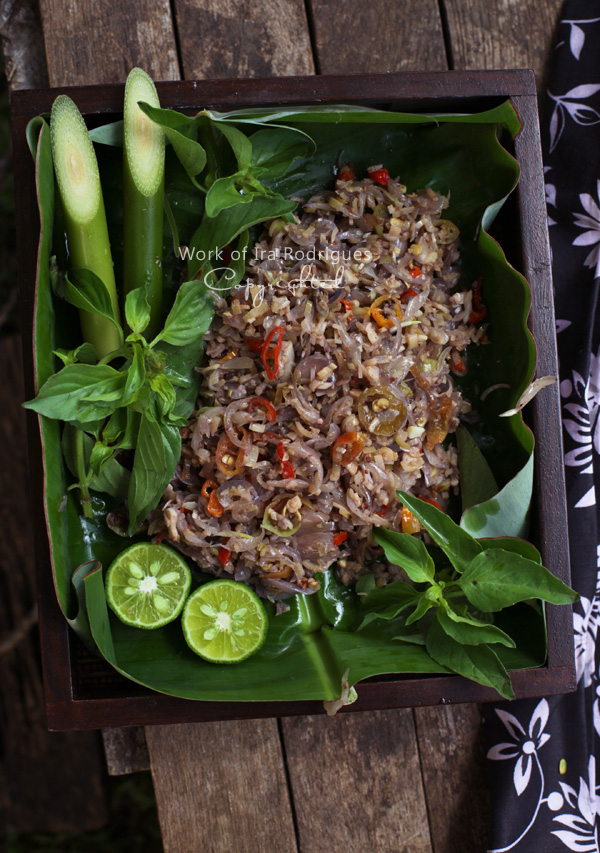Balinese cuisine is complex and involves several flavors at once. This post is dedicated to highlighting the distinct flavors of Bali, including key rhizomes and roots, nuts and seeds, herbs and leaves, and spices used in Balinese cuisine.
For me, it’s hard to find the individual flavors of Balinese dishes. The other day I was enjoying some “tum tofu” (steamed tofu wrapped in banana leaf) and kaffir lime was the most present ingredient on my pallette. Most of the time though, the cuisine is more like an entire orchestra where you can’t distinguish the violin from the upright bass. It’s everything all at once.
The Balinese tend to use all of the same spices for every dish. They make a spice paste called “basa gede” or “bumbu Bali” out of shallots, garlic, chili, galangal, turmeric, and ginger. Basa gede kinda makes every dish taste the same, whether you’re eating tempeh or sayur (veggies) or ayam (chicken). I initially found this incredibly unsatisfying, but now I enjoy this flavor(s) as it is distinctly Bali. In the words of Mark Davis in A Taste of Place, “terroir is character. It is the triumph of diversity over homogeneity.”
Fragrant spices (Balinese 8 spice combo): white pepper, black pepper, coriander, cumin, clove, nutmeg, sesame seed, and candlenut.
Common roots: shallots, garlic, galangal, turmeric, ginger, and resurrection lily.
Here’s what I’ve learned about some traditional Balinese flavors that are new to my palette:
GALANGAL (KENCUR/LENGUKAS)– Also known as Resurection Lily, galangal is a rhizome in the ginger family. It is commonly mistaken for ginger but is slightly larger. There are two varieties, lesser galangal and greater galangal. Greater galangal, lengukas, has an ivory flesh and mild sharp sweet taste. It is often used in nasi kuning, or yellow rice. Lesser galangal, kencur, has very strong flavor that is used in combination with other spices for many dishes.
image source: www.kitchenkonfidence.com
TAMARIND (ASAM JAWA)– Tamarind has a very sour taste. The tamarind seed is in the fruit, so you must soak the seed in water and use the liquid to cook with. A popular dish using tamarind is ayam panggang bumbu terik, or tamarind chicken.
KAFFIR LIME (JERUK PERUT)– Also called “limo” in Bali. Both leaves and fruit are used in Balinese cuisine.
FERN TIPS (PAKU TANJUNG)– Yes, edible ferns! I couldn’t believe it. The Balinese use fiddlehead fern as a vegetable. It is usually steamed with garlic like spinach.
image of paku tanjung. source: manfaat.co.id
CASSAVA LEAF & ROOT (KETALA)– Also called yucca, this is a starchy tuber that grows super easily. There are many health benefits of both the root and leaf, especially for the digestive system. My vegetarian co-workers, Natale and Mari, survived off cassava for several weeks when they were living in Tonga.
PANDAN LEAF (DAUN PANDAN HARUM)- Pandan is a versatile leaf. You will find it shredded in Hindu offerings, made into medicine for skin and mouth diseases, used as a coloring agent for foods (hello green pancakes!), in desserts such as rice pudding, as tea, or cooked. The flavor is sweet and refreshing. Oh, and it grows absolutely everywhere.
image of pandan. source: 3.bp.blogspot.com
LEMON BASIL (KEMANGI)– This is used as a garnish for soups and grilled meats. It is lighter in flavor than lemongrass.
LEMONGRASS (SEREH)- Lemongrass is related to citronella and is therefore great as a mosquito repellent. The bulbous root is what is used in cooking. We use lemongrass a lot in the SV menu, but it is not too common in traditional Balinese cuisine. We used lemongrass to line the living fence of our garden at the village so it is quite abundant here. I like to drink it as a refreshing tea!
CANDLENUT (KEMIRI)– Candlenut is used as a thickening agent for sauces. They are toxic when raw, so they must be cooked before consuming.
PALM SUGAR (GULA MERAH)– Palm sugar is made from the sap of the palm. This carmelized sugar is similar to brown sugar and is a healthier version of white sugar.
GINGER FLOWER- Ginger flowers are pink and are used to make a beautiful spicey garnish called sambal kecombrang. This usually has shallots, red chili, and (traditionally) shrimp paste.
image of sambal source: indonesiaeats.com
Trubek, Amy B. (2008-05-05). The Taste of Place: A Cultural Journey into Terroir (California Studies in Food and Culture) (p. 250). University of California Press. Kindle Edition.






Be First to Comment